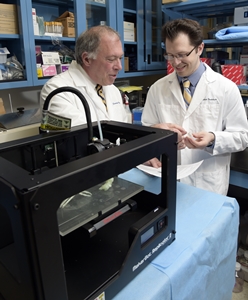
Todd Goldstein, right, with Daniel Grande and the MakerBot 3-D printer used to create windpipe cartilage. (Stratasys Ltd.)
27 January 2015. Researchers at Feinstein Institute for Medical Research in Manhasset, New York devised techniques using a commercial three-dimensional printer for creating cartilage to repair or replace a human trachea or windpipe. Doctoral candidate Todd Goldstein, working in the lab of orthopedic researcher Daniel Grande, presented his proof-of-concept findings at this week’s meeting of Society of Thoracic Surgeons in San Diego. Goldstein is a student at Hofstra North Shore-LIJ School of Medicine.
Damage to the windpipe can be caused by trauma (e.g. gunshot wound), infections, tumors, or mishaps from inserting a breathing tube ina patient. The likelihood of repairing a damaged windpipe, usually with surgery, depends on the type and severity of the injury, but the damage is often difficult to repair.
The solution offered by Goldstein and colleagues combines tissue engineering with advances in 3-D printing. Grande’s lab at Feinstein Institute conducts research on cell-based cartilage repair, including repairs with chondrocytes, key cells in the matrix making up cartilage. Grande’s techniques involve mixing a patient’s own chondrocytes with nutrients and collagen to hold together the regenerated tissue.
The missing element, however, was a structure or scaffold to provide shape for the regenerated tissue, and on which the new tissue can grow. In a statement, Feinstein notes that constructing a windpipe, is a particularly demanding task. “It has to be rigid enough to withstand coughs, sneezes and other shifts in pressure,” notes Goldstein, “yet flexible enough to allow the neck to move freely.”
The researchers turned to 3-D printing to create the windpipe scaffold, and selected the Replicator 2X Experimental model from MakerBot, a subsidiary of Stratasys Ltd. That model sells for about $2,500 and fits on a desktop. The researchers found on the company’s Web site a technique that combines 3-D printing with polylactic acid (PLA), a biocompatible polymer, with biomaterials, applied from separate extruders.
Using a 3-D printer, the researchers were able to quickly create and test different designs for the windpipe scaffold. “With 3-D printing,” says Goldstein, “we were able to construct 3-D printed scaffolding that the surgeons could immediately examine and then we could work together in real time to modify the designs.”
While PLA is a biocompatible material and used in surgical implants, a question arose if PLA applied from filament would be sufficiently sterile for a reconstructed windpipe. The researchers discovered the heat from the extruder is high enough to sterilize the PLA as it was applied, making it possible to use MakerBot’s standard PLA filament. A second extruder on the printer applies the cell material in the form of bio-ink that fills in the gaps at room temperature on the scaffold.
The team reports that the cells extruded through the 3-D printer survived the process and were able to grow on the scaffolding into an extracellular matrix — a type of supporting cells — typical of windpipe cartilage. They 3-D printed a 2-inch section of windpipe in about 2 hours.
The printed windpipe, described as looking like a hollowed-out Tootsie Roll, is then cured in a bioreactor. Goldstein was able to build a custom-made bioreactor, scavenging available parts and 3-D printing the parts he needed. A new bioreactor, notes the researchers, costs from $50,000 to $150,000.
While the reported study may prove the concept, say the researchers, that concept needs to be developed further and refined into techniques that can be tested with humans and submitted for Food and Drug Administration approval. In the meantime, MakerBot is providing Feinstein Institute with samples of other materials that could be engineered into other 3-D printed tissue, such as bone.
Read more:
- 3-D Tissue Assembly System Designed
- University Prof to Commercialize 3-D Printed Cell Platforms
- Yale Univ, Organovo to Develop 3-D Print Transplant Tissue
- 3-D Bio Modeling, Illustration Software Designed
- Implanted Heart Membrane Device Created by 3-D Printer
* * *

 RSS - Posts
RSS - Posts
You must be logged in to post a comment.